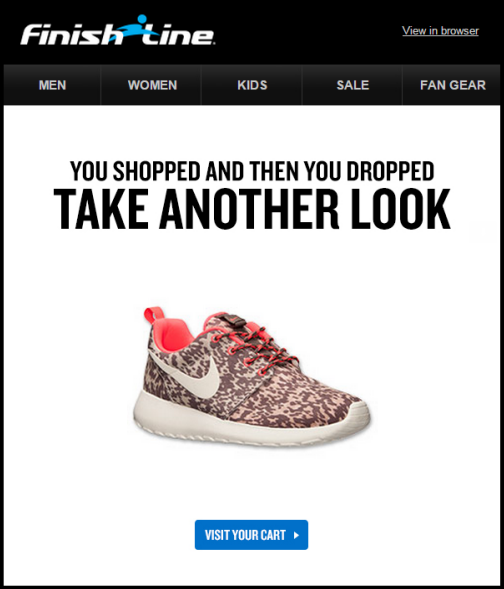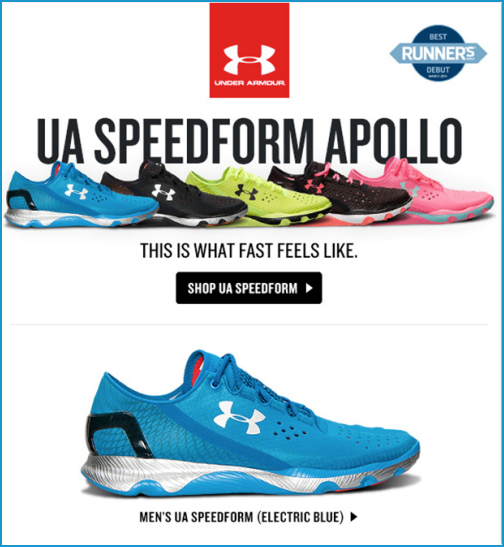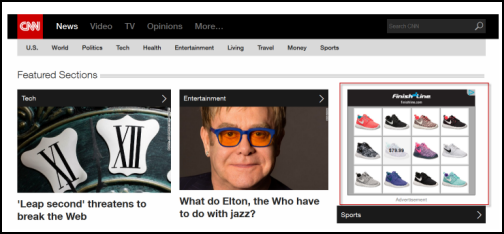by
Erin Hogg, Reporter
Finish Line, a top athletic footwear and apparel retailer, has approximately 1,040 Finish Line branded locations, primarily in U.S. malls and shops inside Macy's department stores. However, its efforts don’t stop there — Finish Line has established a significant online presence.
According to Danielle Quatrochi, Vice President of Digital, Finish Line, the brand focuses on the customer first, meaning it’s less about which channel they shop from and more about serving customers at any touch point in the most relevant way for them.
THE CUSTOMER
For Finish Line, the target consumer is the millennial, but they connect with the many different personas that visit their digital properties. While so much of Finish Line's business is athletic-footwear driven, the marketing teams understand the customer may wear the product for uses beyond athletics.
"Our goal is to understand who makes up the traffic that visits to our site every day a bit more granularly and to get a good grasp on what each customer segment is interested in," said Aaron Buchanan, Digital Personalization Manager, Finish Line.
For example, in targeting the many personas in the women's category, there are customers who are casual-athletic focused, very technical runners and more fashion-forward with athletic apparel. The combinations are endless, and Finish Line strives to meet customer needs, wherever their interests lie.
CHALLENGE
To meet the needs of customers across a wide range of potential personas, Finish Line's email marketing communications were segmented to target specific audiences.
According to Buchanan, in the beginning, the process was basic segmentation, sending out emails based on what areas of products a customer normally purchases.
However, the marketing team realized that they could be achieving much higher engagement rates with their email campaigns. The team started looking at ways to make Finish Line's email communications much more relevant and engaging for the right audience.
The marketing team noted that every time a customer comes to the Finish Line website — which is hundreds of thousands of instances every day — each interaction is a customer trying to have a conversation with the brand.
"Each little interaction on the website has been telling us more and more about who they are and what they're interested in," Buchanan said.
Ultimately, the marketing team began looking into how they could tag the site to monitor all of these behaviors and develop a deeper understanding of who the customers are. In particular, the team was interested in behaviors when a customer clicks through an email and starting to derive some preferences of who the customer is so Finish Line can target them better.
"The end goal within the email program is getting more opens, more clicks and better conversion and to better sustain engagement for greater lifetime value," Buchanan said.
CAMPAIGN
This need for better customer targeting had been on Buchanan's and the marketing team's minds for the past few years. The team strategized how they were going to implement and act on it in 2012, and they began putting together the right tools to make it a reality for Finish Line.
In order to gain buy-in to leverage complex tools, Buchanan and the team needed to prove that more targeted email campaigns would be a huge asset for Finish Line.
The team put together some basic tests with abandonment series that would help the marketers understand what was in the cart and what the customer was browsing for upstream and downstream to uncover potential reasons as to why they abandoned and how to re-engage the customer.
"If we're able to monitor customer behavior and understand some deeper proclivities, we're able to reach them with a much more compelling, meaningful message to get them to convert," Buchanan said.
These insights from customer behavior proved to be an essential element to understanding customer motivation, and Buchanan and the team got the green light to continue.
At this point, the website was tagged to track customer behavior, and the solution was integrated into Finish Line's email service provider to add automation capabilities, taking out the manual work of reacting to opportunities with a triggered campaign.
Tagging across the website allows the marketers to understand what products, categories and content the customer is engaging with as well as where the traffic originated.
"A big part of it is understanding where the traffic originates and what their downstream interactions on the site become," Buchanan said.
Step #1. Partner with a solution provider and implement tools
Before Buchanan and the team could really dive in and understand customer behavior, they had to find a solution partner that would be aligned with what Finish Line wanted to accomplish with email and personalization.
Buchanan vetted vendors to find one that would be able to monitor site behavior and be able to react with basic intelligence, understanding what content customers engage with, as well as why they abandon the site and react with highly targeted, automated campaigns.
Those were the core pieces of what Buchanan looked for in a partner. In addition, a big pro for a solution provider was having an interface where he could build more advanced segments off all of the behavior on the site and have that integrate directly with the ESP.
The marketing team, having been well-versed in building advanced segments at that point with the data they did have, found this new solution intuitive and hit the ground running by launching highly personalized, segmented campaigns.
With the solution, the marketing team is able to look at potential customer scenarios along with the number of customers that would be targeted.
This aids in resource allocation, as a campaign that targets 500,000 customers in one persona would be more advantageous than targeting one that had 5,000.
Step #2. Infuse marketing needs into existing creative production processes
Once Buchanan implemented the solution, the capabilities for hyper-segmentation were seemingly endless.
"[We were] not only able to create that one email that's going out to a fairly large segment, but also send a highly-versioned campaign that could have five different pieces of creative supporting the single initiative, each dynamically populated for unique audiences," Buchanan explained.
However, with multiple segmented versions of email campaigns being sent, this suddenly put a tremendous load on the Finish Line creative team. Buchanan needed to support the segmentation and personalization strategy without having to hire new designers overnight.
The solution arose by determining how the team could repurpose creative that was used in other places in Finish Line's digital marketing and create modular elements that can be used in various initiatives.
For example, the creative team will go on photo shoots, and the team will pull together pieces of creative that can be used for the season, such as a theme around spring.
By thinking ahead and figuring out how the marketing team can make simple copy changes in the email, such as in the text and calls-to-action, the team can still achieve personalization without burdening the creative team to create entirely new campaigns for each email segment.
"It's all about being nimble enough to support the audiences that we identified as our best opportunities, but not delaying the process by having to produce custom creative as the opportunity slips by," he explained.
Step #3. Segment subscribers
In ramping up to the holiday season, Buchanan explained that the team at Finish Line was simultaneously running 300 segments to push the company's biggest marketing effort of the year.
These targeted sends included trigger-based communications,
cart abandonment emails, messaging to the loyalty program users and much more.

Click here to see the full version of this creative sample
Segmentation with Finish Line's core group of customers includes gender-based and brand affinity-based targeting.
The team can also target based on geolocation and what teams and schools a customer has an affinity for, which Finish Line supports through
NCAA- or NFL-related offers.
"That can be based on what we see them doing in social media when the traffic comes to the site or their geolocation," Buchanan explained.
An example of one such campaign recently executed was in support of Chicago Bulls player Derrick Rose and the launch of his new show. Finish Line can identify the core group of customers that exist in the basketball segment and, within that, can hone in on the Chicago area. This segment is more likely to convert rather than sending out the campaign to anyone with an affinity to basketball.
"Oftentimes, with those types of campaigns, we can create enough support just by getting an extremely targeted audience’s attention in the right place at the right time," Buchanan added.
Beyond demographic and behavior values Finish Line can identify, the marketing team can also analyze what would be a predicted next purchase for a customer.
This can include sending campaigns to follow up a purchase with a cross-sell offer. For example, if someone comes in-store or online and purchases a new pair of tech running shoes, the marketing team can follow up with apparel offerings that customer might be interested in.
On the flip side, Finish Line can
follow up an apparel purchase with a shoe offering to help establish customer awareness of its latest footwear styles. This type of targeting can benefit the customer by sending relevant offers as well as supporting business goals.

Click here to see the full version of this creative sample
Don't overstep self-defined preferences
Finish Line offers a
customer loyalty program, called Winner's Circle, in which customers can self-identify their preferences in their profile.
This includes what brands, teams and activities they are interested in, which gives the marketing team an idea of what content they should promote.
In addition, the marketing team can also target those customers who do not self-identify their preferences based on their browse behaviors.
This does not cancel out the messaging based on how the customer identified themselves but adds to their experience with Finish Line by deriving their preferences from their activity throughout the website.
Speaking to the loyalty program segment specifically, Finish Line can also target that audience on the website with banner messaging related to their point-based reward system.
The team also has the ability to drive repeat transactions by alerting customers when their rewards are close to expiring across multiple channels, such as email and mobile app push notifications as well as messaging on the site.
"All of these unique values assigned to Winner's Circle customers are leveraged via automated segmentation to maintain customer engagement and utility,” Buchanan said.
Step #4. Unify multichannel efforts
To keep users engaged across the spectrum, the digital marketing team has unified email, on-site and mobile messaging, social media and display ad marketing efforts.
The team builds out audience segments based on what they know about their customers, including on-site browse behaviors, past purchase behavior, what they are searching for and what the traffic source was.
This helps to identify those customers that would be more interested in a particular product offering.
For example, for a particular Nike Air Max campaign, the team can export a list of email addresses just like they would for an email campaign and load them into Facebook. From there, they can find, based on that list, a much broader reach of fans.
Customers are also
targeted via display ads.

Click here to see the full version of this creative sample
When a user comes to the Finish Line site from an ad or link for that particular campaign, Buchanan explained how important it is to continue that conversation by displaying the right promotion for them.
"Say you land on a grid of fashion-forward running shoes, and at the top of that page you have a banner that isn't necessarily speaking to the campaign that you were just engaged with. We can improve conversion for that traffic by reinforcing that you're in the right place," he added.
Don't isolate customers into an experience
Buchanan added that it's important to be careful to not isolate those shoppers into an experience just because they qualify for a particular campaign.
"I don't want to take over your entire shopping experience with one really focused initiative. I still want there to be opportunities to explore other parts of the site," he said.
The marketing team accomplishes this by recognizing the user's behavior changes during a session and serving up relevant offers based on that shift.
Step #5. Optimize site content
In addition to the segmentation of email subscribers, Buchanan and the team optimized content on the website to achieve more relevancy with customers.
For example, frequently on the site, visitors might see basketball-related promotions displayed on the homepage.
Finish Line identified that a significant portion of the traffic to the site tends to be the women shoppers and can swap out particular promotion spots to something more relevant to that particular segment.
Even more granularly, if the marketing team sees one of those users has a high level of engagement with a specific brand category, the promotions featured in their navigation path can be swapped out to better fit that visitor's brand affinity.
Step #6. Test email campaigns to ensure effectiveness
Aside from testing subject lines and creative elements, Buchanan strives to test and confirm that the segmentation efforts are truly working for the brand.
For example, one campaign could go out supporting men's running and, within that target audience, there is also a group that only ever converts on sale items.
The marketing team can serve a campaign for that audience to elevate the items that are on sale. Within that, to make sure the team is on the right track and not just perpetuating a lower margin for that audience, it is tested against a control creative that's not targeted to deal shoppers.
Through this testing, the team can compare conversion rates to the deal-seeking shopper segment to confirm that they are achieving success by supporting what is most likely to convert for that particular audience and balancing margins.
RESULTS
"I think most of our success has come from really paying attention to what the customer is telling us through their behavior … [and] being considerate of how they engage with the brand across all the channels. From there, we can continue the conversation in the appropriate way," Buchanan said.
As a result from Finish Line's transformation from simple segmentation to intelligent automation and targeted segmentation, Buchanan has achieved the following:
- 50% increase in email revenue for trigger-based programs
- 2.5-times increase in overall website effectiveness (the KPI being conversion) from content optimization
- Margin dollar increases of up to 15% by identifying serial comparison shopping customers and re-engaging them
- 14% increase in category sales (e.g., women's category) based on audience optimization strategies
- 30% increase in gross return on ad spend for Facebook advertising
Buchanan's biggest takeaways from his efforts at Finish Line include learning that having the right conversation with customers can extend their lifetime value, but he warned it is possible to take it too far, alienating customers with hyper segmentation.
During the holiday season, for example, a customer who would be normally engaged with men's basketball but looks at girl's sneakers for a gift shouldn’t be targeted with content personalized for their typical behavior during that time. Buchanan added that it's key to be cognizant of how personalization has to change according to seasonality.
"Honor the conversation the customer is having with your brand via their actions across all of your channels," Buchanan concluded.
Interested in learning more? Buchanan will be presenting more details on this campaign and how Finish Line transformed from basic segmentation to multichannel nirvana at MarketingSherpa Email Summit 2015.Creative Samples
- Cart abandon email
- Geolocation-based email
- Under Armour send
- Winner's Circle loyalty program
- Facebook and display ad retargeting
Sources
Finish LineSmarterHQRelated Resources
B2C Best of 2014: Top takeaways in Web optimization, mobile marketing and emailMarketing Automation: 2,500% email list growth for B2B cloud enterprise solutionMarketing Automation: 25% more engagement, 0% unsubscribe in 4-email seriesMarketing Automation: Implementation drives $550,000 in net new revenue at Crain's












